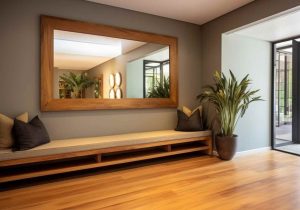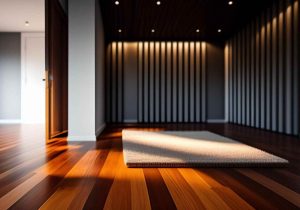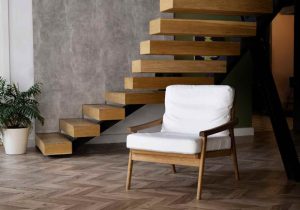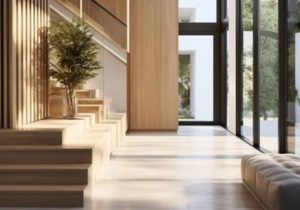Plywood is an extremely popular material to consider when designing your home interiors. However, it’s crucial that you understand the different types of plywood available and their benefits and drawbacks. Plywood offers a host of different benefits. The primary one, and also the reason for its immense popularity is that it’s cheaper than solid wood, and yet durable enough to last you years. If you’re looking to use waterproof plywood across your home’s interiors, we’ve got you covered.
In this guide, we take you through the various types of waterproof plywood available in the market, their sizes, prices, benefits, and more.

In simple terms, plywood is a type of engineered wood that’s made by gluing together multiple “plys” or veneers of wood and bonding them with heat and pressure. The result is a durable alternative to solid wood that can be tailored to meet the specifications of your home’s interiors.
The durability that plywood boasts comes from placing the wood grains of alternating layers at right angles to each other. Now, plywood, particularly waterproof plywood, comes in various different types and grades and is typically used in spaces that see a great deal of exposure to water. These spaces typically include bathrooms and kitchens.

The versatility plywood offers, along with its cheaper price and resistance to warping and shrinking make it incredibly popular in home interior design. You can use plywood across various elements, including –
What’s more, waterproof plywood can also be a great material to use for decorative elements, such as arches, panelling, and cladding.
There are several different types of plywood available in India, each with its own qualities and pros and cons. They’re differentiated based on the kind of wood used to make them, along with their application and the overall process.
Regardless of all these varieties, however, there are three primary types of plywood that are commonly used in home interiors. These include-
In the forthcoming sections, we take a look at some of the most popular types of plywood that you can consider using across your full home interiors.

What local vendors often call “commercial ply,” MR is the ideal type of waterproof plywood for homes in humid conditions. They offer good resistance to moisture, making them a popular choice for use in home interiors.
The resin used to make MR sheets is urea formaldehyde, which is the key element in making it resistant to water or dampness. To put it specifically, it can withstand being exposed to water at 60°C for up to three hours.
Boiling Water Resistant sheets are a brilliant choice both for your home’s interiors and exteriors. In fact, their exceptional resistance to moisture makes them perfect for cabinets in spaces like kitchens and bathrooms. However, you can also use them for your TV cabinet, for example, particularly if you want a more durable material.
The key reason for its popularity is that it’s resistant to boiling water for a period of up to 8 hours. If you intend to use BWR for your home’s exteriors, you can use it for your wall cladding or even on your staircases. Its resistance to water makes it an incredibly durable option to consider.

Boiling Water Proof plywood, Marine Ply, which withstands exposure to boiling water for up to 72 hours, is also commonly referred to as Marine Ply.As a result, this grade often finds use in industries that tend to have higher exposure to water.
Since BWR typically offers all the water resistance needed in a residential setting, marine ply typically doesn’t need to be used in home interiors. However, if you want to be stress-free about your home interiors, particularly in spaces like your kitchen and bathroom, you can still choose to use this type.
As its name suggests, Flexible Waterproof Plywood is a type of waterproof plywood that can be bent without breaking. As a result, this makes it ideal for statement pieces that have unique designs or structures. While you can use them across unique pieces of furniture, you can also use them in doorways, particularly if you want to play around with arches.
People commonly use hard plywood across pieces that require a sturdy material. Its core material comprises the wood of trees like mahogany and red maple. Its solid structure and immense durability make it the ideal choice for use on floors or in transportation containers, making it a pricier option when compared to the other, more commercially used options.
Soft plywood, made from trees like Douglas, fir, or maple trees, is perfect for countertops, cupboard exteriors, and floors, unlike hard plywood. Alternatively, one can use it as a material for fencing. They’re comparatively less expensive when compared to hard plywood, making them affordable to replace after a few years of wear and tear.

Aside from the categories mentioned above, there are several other factors that play a crucial role in choosing the right plywood for your home interiors. These include the thickness of the plywood, its grades, and the size required. We discuss each factor in greater detail below.
The term “ply” refers to a layer, and it refers to how thick a sheet of plywood is. The more the ply, the thicker the board, resulting in greater durability. Typically, the minimum thickness you can find is 3-ply, which is the thinnest grade. The most common thicknesses include –
Waterproof plywood sheets often come in a variety of grades that determine their overall quality and appearance. They also play a crucial role in determining the prices of plywood sheets, as a result. The most common grades available are mentioned below –
Plywood sheets are typically available in a few standard sizes, making it easy for you to procure them based on your requirements. The most popular dimensions you can find plywood sheets in are 4 x 8 ft. However, another common alternative is 7 x 4 ft.
In terms of thickness, plywood sheets typically come in a thickness of 18mm, but you can also get them in others such as 16mm, 12mm, 8mm, and 6mm.
Choosing the right waterproof plywood for your home interiors can be challenging, especially since they’re available in various different grades, thicknesses, and qualities. However, this is where Bonito Designs can help you. As India’s only ISO-certified full home interior brand, we ensure the use of the best materials for every part of your home interior.
We ensure tailored perfection and ultimate durability by conducting 7 stages of key quality checks and over 400 tests on every element.